Fender Princeton-Chorus-DSP Operation Manual
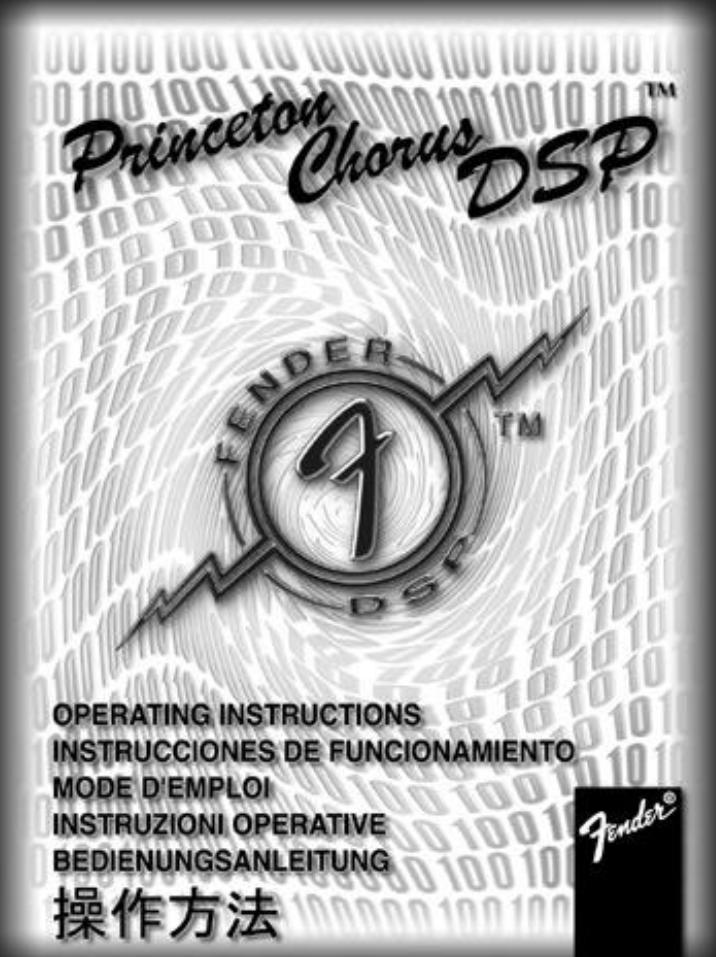
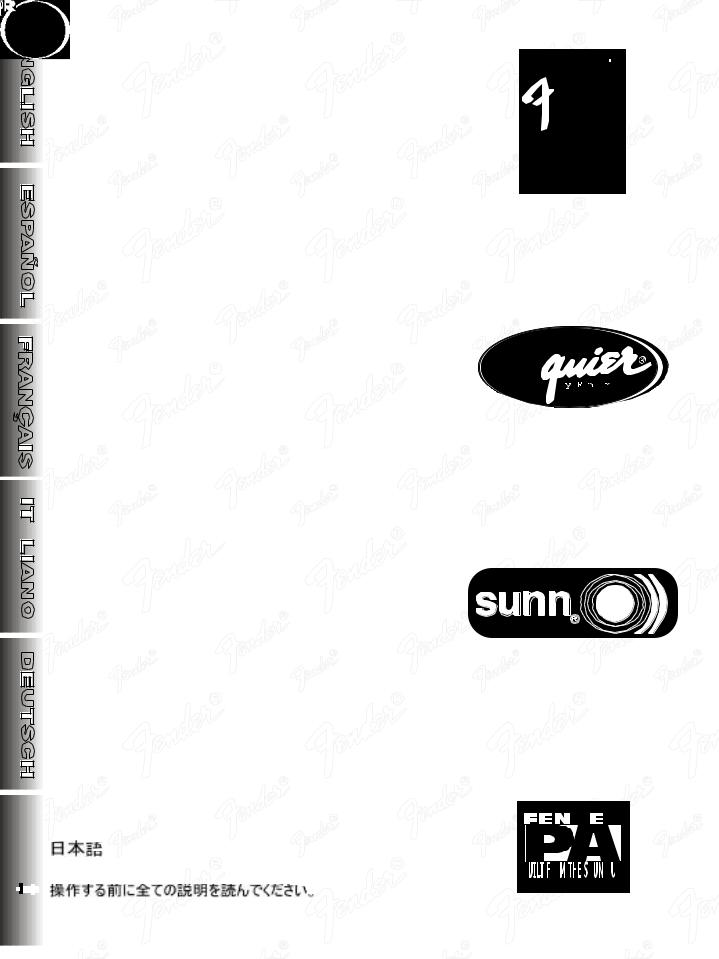
ENGLISH - PAGES 4-9
READ ALL INSTRUCTIONS
BEFORE OPERATING UNIT!
ESPAÑOL - PÁGINAS 10-15
¡LÉANSE ANTES DE UTILIZAR EL APARATO Y GUARDENSE PARA SU USO POSTERIOR!
FRANçAIS - PAGES 16-21
16-21
PRIERE DE LIRE AVANT L’EMPLOI ET A CONSERVER POUR UTILISATION ULTERIEURE!
 ITALIANO - PAGINE
ITALIANO - PAGINE 22-27
22-27
LEGGERE ATTENTAMENTE PRIMA DELL’USO E CONSERVARE PER UN UTILIZZO SUCCESSIV0!
DEUTSCH - SEITEN 28-33
BITTE VOR GEBRAUCH LESEN UND FÜR SPÄTEREN GEBRAUCH AUFBEWAHREN!
SPÄTEREN GEBRAUCH AUFBEWAHREN!
- 34-39
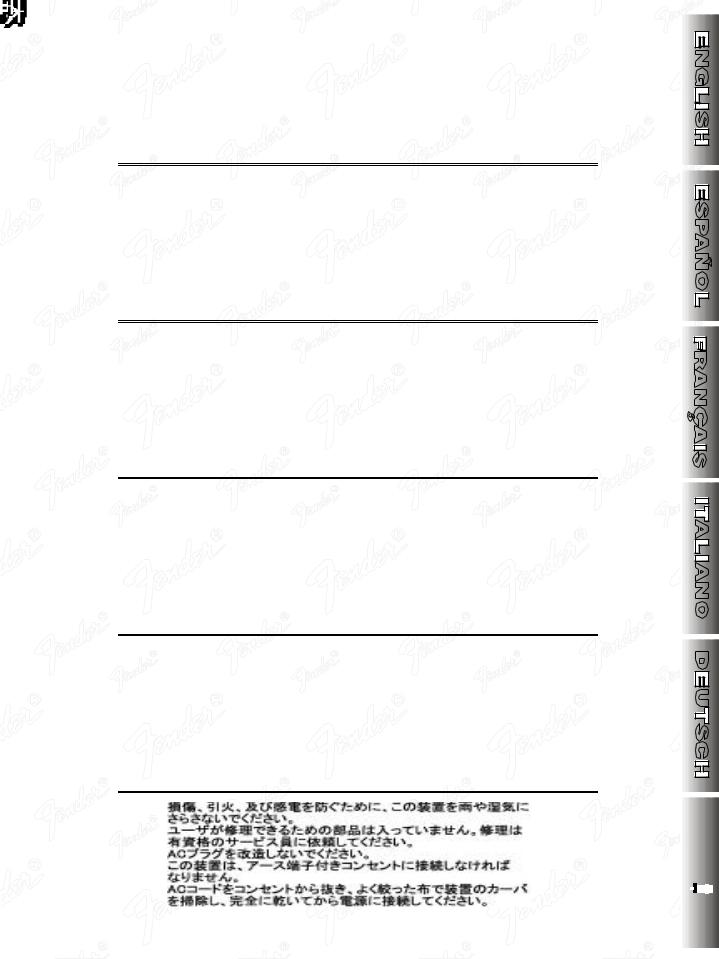
• TO PREVENT DAMAGE, FIRE OR SHOCK HAZARD, |
• THIS UNIT MUST BE EARTH GROUNDED. |
|
|
DO NOT EXPOSE THIS UNIT TO RAIN OR MOIS- |
• UNPLUG THE AC POWER LINE CORD BEFORE |
|
TURE. |
CLEANING THE UNIT’S COVERING WITH ONLY A |
• |
NO USER SERVICEABLE PARTS INSIDE, REFER |
DAMP CLOTH; WAIT UNTIL THE UNIT IS COM- |
|
SERVICING TO QUALIFIED PERSONNEL ONLY. |
PLETELY DRY BEFORE RECONNECTING IT TO |
• DO NOT ALTER THE AC PLUG. |
POWER. |
|
• PARA EVITAR DAÑOS, INCENDIOS Y DESCARGAS |
• ESTA UNIDAD DEBE CONECTARSE CON TOMA DE |
|
|
ELÉCTRICAS, NO EXPONGA ESTA UNIDAD A LA |
TIERRA. |
|
LLUVIA NI A LA HUMEDAD. |
• DESCONECTE EL CABLE DE ALIMENTACIÓN DE |
• CONTIENE PIEZAS CUYO MANTENIMIENTO NO LO |
CA ANTES DE LIMPIAR LA CUBIERTA DE LA |
|
|
PUEDE REALIZAR EL USUARIO, SINO SÓLO PER- |
UNIDAD; ESPERE A QUE LA UNIDAD ESTÉ COM- |
|
SONAL CUALIFICADO. |
PLETAMENTE SECA ANTES DE VOLVER A CONEC- |
• NO MODIFIQUE EL ENCHUFE DE CA. |
TARLA A LA CORRIENTE. |
|
• |
POUR EVITER L'ENDOMMAGEMENT DE L'AP- |
• NE MODIFIEZ PAS LA PRISE DE CA. |
|
PAREIL, UN DEPART D'INCENDIE, OU UN CHOC |
• CET APPAREIL DOIT ETRE MIS A LA TERRE. |
|
ELECTRIQUE, NE L'EXPOSEZ JAMAIS A L'HU- |
• DEBRANCHEZ LE CABLE D'ALIMENTATION AVANT |
|
MIDITE OU A LA PLUIE. |
DE NETTOYER LE BOITIER DE L'APPAREIL ET |
•AUCUNE MAINTENANCE NE DOIT ETRE  ATTENDEZ QUE L'APPAREIL SOIT COMPLETE-
ATTENDEZ QUE L'APPAREIL SOIT COMPLETE-
EFFECTUEE POUR LES PIECES SITUEES DANS L'APPAREIL. LES REPARATIONS ET LA MAINTENANCE DOIVENT ETRE EXECUTEES UNIQUEMENT PAR UN PERSONNEL QUALIFIE.
MENT SEC AVANT DE LE REBRANCHER SUR LE SECTEUR.
•PER EVITARE DANNI, RISCHI DI INCENDI O • QUESTA UNITÀ DEVE ESSERE COLLEGATA A
SCOSSE ELETTRICHE, NON ESPORRE QUESTA UNITÀ ALLA PIOGGIA O ALL'UMIDITÀ.
•NON CONTIENE PARTI RIPARABILI DALL'UTENTE: FARE ESEGUIRE LA MANUTENZIONE SOLTANTO DA PERSONALE QUALIFICATO.
•NON ALTERARE LA PRESA C.A.
TERRA.
•DISCONNETTERE IL CAVO DI ALIMENTAZIONE C.A. PRIMA DI PULIRE LA COPERTURA DELL'UNITÀ; ATTENDERE CHE L'UNITÀ SIA COMPLETAMENTE ASCIUTTA PRIMA DI RICOLLEGARLA ALL'ALIMENTAZIONE.
•SETZEN SIE DIESES GERÄT NIEMALS REGEN • MANIPULIEREN SIE AUF KEINEN FALL DIE NET-
ODER FEUCHTIGKEIT AUS, UM BESCHÄDIGUNG, |
|
ZANSCHLUSSBUCHSE. |
BRANDENTWICKLUNG UND ELEKTRISCHE |
• |
DAS GERÄT MUSS GEERDET SEIN. |
SCHLÄGEN ZU VERMEIDEN. |
• |
STECKEN SIE DAS NETZKABEL AUS, BEVOR SIE |
•IM GERÄT SIND KEINE ZU WARTENDEN TEILE. DAS GEHÄUSE DES GERÄTS REINIGEN.
WARTUNG UND REPERATUREN DÜRFEN NUR |
SCHLIESSEN SIE DAS GERÄT ERST WIEDER ANS |
||
VON |
QUALIFIZIERTEN |
TECHNIKERN |
STROMNETZ AN, WENN ES VOLLSTÄNDIG |
DURCHGEFÜHRT WERDEN. |
|
GETROCKNET IST. |
|
3
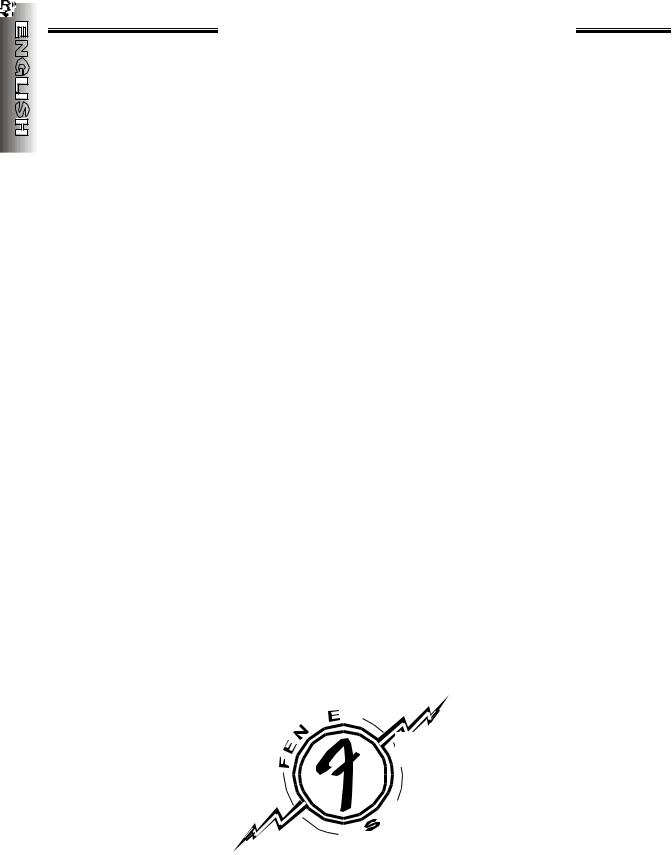
PRINCETON CHORUS DSP - FEATURES
Ba sed |
on th e |
cl as sic d esig n |
o f t he |
or i gi nal |
Fen de r Pr inc eton |
S t e re o C h o r u s ™ a m pl i f i e r, t h e P rin cet on C ho rus D SP i s u pd ated w i th D i g i t al S ig na l P r o c e s s i n g .
D e v e l o p e d i n F e n d e r ’s o w n
Dig it al |
La bo r atory, th e Pr ince ton |
|
C h o ru s |
D SP feat u res |
32 st u di o- |
q ual it y |
Ste reo E ff e cts |
tha t u ti li ze |
t wi n pow er- a m p l i f i e r s t o m a i n t a i n t o tal s t e re o - s e p a r a t i o n . A se lec- t abl e Overd rive Mo de ma k es t his v i r tual ly a tw o- chan nel a m pli fier!
T h e O v e rd r i v e M o d e f e a t u re s e x c l u s i v e F e n de r P re - & D e - E m p h a s i s D i s t o r t i o n C i rc u i t r y
t h a t p ro d u c e s |
t h e s e a r i n g |
||
s m oo th |
hi g hs |
a nd de e p |
p u n ch |
like t ha t |
o f an |
o verdr iven |
st ac k |
t u b e - a m p l i f i e r. |
|
|
|
T he MI D B OOS T |
s wi t ch pro v i d e s |
an ot he r p r e-em pha si s v o ice w h i l e |
|
t h e P R E S EN C E |
c o n t r o l g i v e s |
con t inu ous v ari at ion of t h e hig h- |
|
f r e q u e n c y c o n t e n t i n t h e d e - |
|
em pha si s vo icin g. Th re e - B a n d E q u a l i z a t i o n C i rc u i t r y l o c a t e d
p o s t - d i s t o rt i o n , s e rv e s t o |
f urt h e r |
mod if y t he ov era ll s ou nd |
o f the |
a m p l i f i e r. |
|
A un iq ue LIM ITE R c ont ro l |
is d i s- |
t o rt i o n - a c t i v a t e d a n d set s |
ex ac t |
l im i ts t o dis tort i on wit ho ut l osi ng t h e su st ain u suall y p roduc e d b y hig h GA I N set ting s. A d ynam ic e ff ect can b e achi ev ed w ith b oth
t h e L IM IT ER |
an d GA I N at hig h |
s ett in gs; th e |
ha rd er t he gui ta r is |
p i c k e d , |
t h e c l e a n e r t h e n o t e |
|
b eco me s! H a rm o n i c - c o n t e n t |
w i l l |
|
als o i ncrea se as t h e not es |
are |
|
all ow ed |
to s ustai n . |
|
The included 3-Button FOOTSWITCH a llo ws re mo te swi tc hin g o f the O v e rd rive Mo de an d DS P St e re o E ffect s. Mu ltip lex e d ove r a s tan - d a r d 1 / 4 - i n c h p a t c h c o r d, th e FO OT SWI TC H is e asi ly con nected t o remo t e ped albo ard s .
The ve rs atili t y o f t he Pr i nceto n C h o r us DSP is gre a tly e xpa nde d w ith Tru e - S t e reo and Bala nce d- M o n o E F F E C T S L O O P S w h i c h ena ble co nn ectio n to a wi de vari - e t y o f e q u i p m e n t i n c l u d i n g r e c o rd i n g / s o u n d - re i n f o rc e m e n t m i x e r s , s l a v e a m pl i f i e r s a n d e ffe cts de vi ces.
4
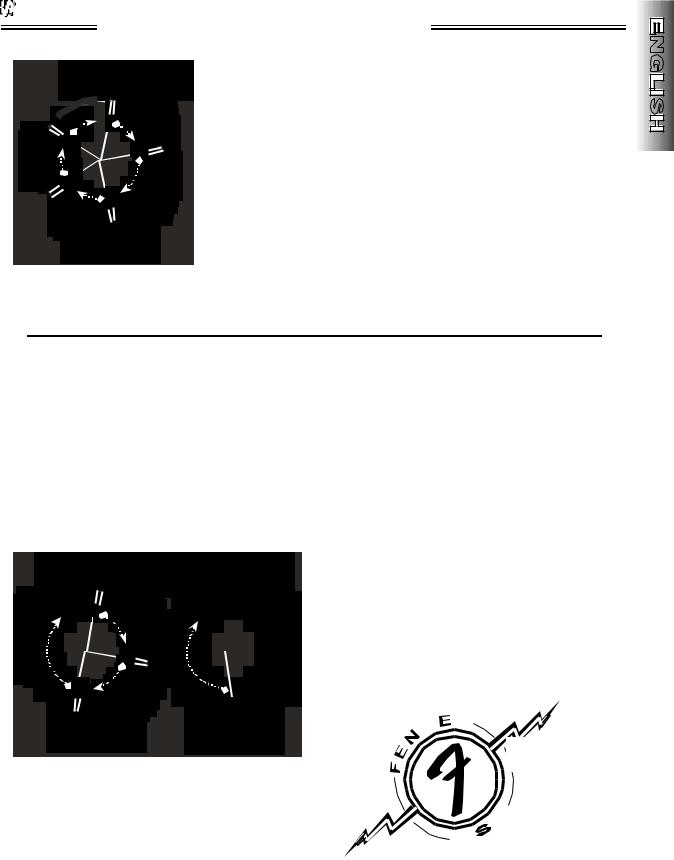
DSP STEREO EFFECTS - CONTROLS
• REVERB/DELAY (FIG. A): Select from 5 TYPES of effects with the TYPE knob :
DELAY/REVERB - A blend of delay and reverb
DELAY - A multi-tap digital delay
ROOM - A simulation of medium-size room acoustics
HALL - A simulation of large-size hall acoustics
PLATE - A simulation of studio plate reverb
A range of preset REVERB/DELAY RATES can be selected within each TYPE (numbered in sets, FIG. A). The preset
RATES get slower going clockwise within that TYPE (direction FIG. A of arrows, FIG. A). For instance, presets numbered “1” in FIG.
A, will have the fastest REVERB/DELAY RATES.
• CHORUS/MODULATION (FIG. B): Select from 3 TYPES of effects with the TYPE knob:
CHORUS 1 - A modern, lush chorus
CHORUS 2 - A reproduction of the effect in the original Princeton Stereo Chorus amp FLANGE - An enhanced short-delay effect
A range of preset CHORUS/MODULATION sweep DEPTHS can be selected within each TYPE (numbered in sets, FIG. B). The preset sweep DEPTHS get deeper going clockwise within that TYPE (direction of arrows, FIG. B). For instance, presets numbered “1” in FIG. B, will have the shallowest CHORUS/MODULATION sweep DEPTHS.
• CHORUS/MODULATION (FIG. C): Adjust the sweep RATE with the RATE knob . The sweep RATES get faster going clockwise (direction of arrow in FIG. C). For instance, the RATE numbered “1” in FIG. C is the slowest sweep RATE.
FIG. B |
FIG. C |
5

PRINCETON CHORUS DSP - FRONT PANEL
A.INPUT 1 - A high-impedance plug-in connection for guitars or other instruments.
B.INPUT 2 - A lower-impedance plug-in connection for guitars or other instruments with active pre-amps.
•NOTE: Both inputs have identical impedance when used simultaneously.
C.VOLUME - Adjusts the overall loudness of the amplifier when the Overdrive Mode is not selected ( {I}DRIVE SELECT switch OUT ).
•NOTE: The Overdrive Mode must be selected ( {I}DRIVE SELECT switch IN ) for controls {D}GAIN through {J}VOLUME to function.
D.GAIN - Adjusts the amount of pre-amp gain (distortion). Use with {J}VOLUME to control the overall amplifier loudness.
E.MID BOOST - Activates a special pre-empha- sis filter which accentuates mid-range frequencies when this switch is pressed IN.
F.LIMITER - Adjusts the amount of compression at high {D}GAIN settings. The compression is activated by distortion in the pre-amp, therefore is not as noticeable at low {D}GAIN settings.
G.OVERDRIVE INDICATOR - This LED illuminates when the amplifier is in the Overdrive Mode.
H.PRESENCE - Adjusts the the post-distortion ultra-high frequency range.
I.DRIVE SELECT - Activates the Overdrive Mode when this switch is pressed IN. NOTE: Both {C}VOLUME and the ChannelSelect FOOTSWITCH are disabled when this switch is pressed IN.
J.VOLUME - Adjusts the post-distortion volume. Use with {D}GAIN to control overall amplifier loudness.
K.TREBLE - Adjusts the high-frequency range.
L.MID - Adjusts the mid-frequency range.
M.BASS - Adjusts the low-frequency range.
N.DEFEAT - Mutes the REVERB/DELAY type DSP Effects when this switch is pressed IN. This switch must be OUT to enable remote switching from the FOOTSWITCH.
O.LEVEL - Adjusts the amount of REVERB/DELAY type DSP Effects to be mixed in with the original dry signal.
P.TYPE - This control selects one of sixteen various REVERB/DELAY DSP Effects. The {N}DEFEAT switch must be OUT, the {O}LEVEL control must be above “1,” and REVERB/DELAY on the remote FOOTSWITCH (if used) must be active for this DSP Effect to be heard. NOTE: See “DSP STEREO EFFECTS - CONTROLS,” page 5.
Q.DEFEAT - Mutes the CHORUS/MODULATION type DSP Effects when this switch is pressed IN. This switch must be OUT to enable remote switching from the FOOTSWITCH.
R.LEVEL - Adjusts the amount of CHORUS/MODULATION type DSP Effects to be mixed in with the original dry signal.
S.TYPE - This control selects one of sixteen various CHORUS/MODULATION DSP Effects. The {Q}DEFEAT switch must be OUT, the {R}LEVEL control must be above “1,” and CHORUS/MODULATION on the remote FOOTSWITCH (if used) must be active for this DSP Effect to be heard. NOTE: See “DSP STEREO EFFECTS - CONTROLS,” page 5.
T.RATE - Adjusts the sweep rate of CHORUS/MODULATION type DSP Effects. A lower number corresponds to a slower rate of sweep.
U.DSP PEAK - Flashing of this LED indicates possible clipping (distortion) in either of the DSP Effects circuits. Periodic flashing is normal. If the LED stays on and undesirable distortion is heard, try reducing: {O}LEVEL, {R}LEVEL or the amplifier VOLUME controls.
V.POWER INDICATOR - This LED illuminates when the amplifier is ON.
W.POWER SWITCH - Press IN the bottom of this switch to turn the amplifier ON. Press IN the top of this switch to turn the amplifier OFF.
6

PRINCETON CHORUS DSP - REAR PANEL
PRINCETON CHORUS DSP |
A PRODUCT OF: |
A.IEC LINE CORD CONNECTOR - The line cord must be connected to a grounded AC receptacle in accordance with the voltage and frequency ratings as shown on the rear panel of the amplifier ( {B}INPUT POWER ).
C.FOOTSWITCH - Plug-in connection for the FOOTSWITCH (P/N 0055592000) for remote switching of the Overdrive Mode, and both DSP Effects circuits. NOTE: For proper operation of the FOOTSWITCH, the DRIVE SELECT switch and both DSP Effects DEFEAT switches on the front panel must all be OUT. (A speaker grade cord is preferable to a coax guitar cord for connecting the FOOTSWITCH.)
D.EFFECTS LOOP STEREO SEND - This jack provides a line-level stereo output from the preamp and both DSP Effects circuits of the Princeton Chorus DSP. This output can be used in conjunction with the {E}STEREO RETURN as a patch point for external stereo effects devices. (See “EFFECTS LOOPS - CONNECTION DIAGRAMS,” page 8) The EFFECTS LOOPSSTEREO jacks are standard 1/4-inch Tip-Ring-Sleeve types, with:
•Left channel signal on the Tip •Right channel signal on the Ring
This send can also be used to feed a stereo signal to two channels of a recording or sound reinforcement mixer. Additionally this output can be used to drive another Princeton Chorus DSP as a slave amplifier. This is done by connecting a shielded stereo cord from the {D}STEREO SEND jack of the master amplifier to the {E}STEREO RETURN jack of the slave amplifier.
E.EFFECTS LOOP STEREO RETURN - This stereo jack inputs signal directly to the left and right power-amps. It automatically disconnects the pre-amp and DSP Effects circuits when used. This is useful when using the Stereo Effects Loop option, or when using the Princeton Chorus DSP as a slave amplifier for a stereo signal source.
F.EFFECTS LOOP MONO SEND - This jack provides an impedance-balanced mono output signal from the pre-amp at a point before the DSP Effects circuits. This output can be used in conjunction with the {G}MONO RETURN as a patch point for external mono effects devices. (See “EFFECTS LOOPS - CONNECTION DIAGRAMS,” page 8) The {F}MONO SEND can also be used to send recording and sound reinforcement mixers a dry signal. Additionally this output can be used to drive another Princeton Chorus DSP as a slave amplifier. This is done by connecting a standard guitar cord from the {F}MONO SEND jack of the master amplifier to the {G}MONO RETURN jack of the slave amplifier.
G.EFFECT LOOP MONO RETURN - This balanced jack inputs signal to the stereo DSP Effects circuitry, which drives the stereo poweramp section. It automatically disconnects the pre-amp signal when used. This is useful when using the Mono Effects Loop option or when using the Princeton Chorus DSP as a slave amplifier for a mono signal source. The DSP Effects are active in the slave amplifier so that a true stereo image will be generated if the DSP Effects are used. NOTE: In order to function properly, a dummy plug or an extra guitar cord must be inserted into INPUT 2 on the front panel of the slave amplifier with its VOLUME controls turned down.
FCC COMPLIANCE NOTICE
This equipment has been tested and found to comply with the limits for a Class B digital device, pursuant to Part 15 of the FCC rules. These limits are designed to provide a reasonable protection against harmful interference in a residential installation. This equipment generates, uses and can radiate radio frequency energy and if not installed and used in accordance with the instructions, may cause harmful interference to radio communications. However, there is no guarantee that interference will not occur in a particular
installation. If this equipment does cause harmful interference to radio or television reception, which can be determined by turning the equipment off and on, the user is encouraged to try to correct the interference by one or more of the following measures: •Reorient or relocate the receiving antenna •Increase the separation between the equipment and receiver •Connect the equipment into an outlet on a circuit different from that of the receiver •Consult the dealer or an experienced radio/TV technician for help
7

EFFECTS LOOPS - CONNECTION DIAGRAMS
8

PRINCETON CHORUS DSP - SPECIFICATIONS
|
TYPE: |
PR 424 |
|
|
|
|
|
PART NUMBER: |
022-5700-020 (120V) |
|
|
|
|
|
|
022-5730-020 (240V) Aust |
|
|||
|
|
022-5740-020 (230V) UK |
|
|
||
|
|
022-5760-020 (230V) Eur |
|
|
||
|
|
022-5770-020 (100V) |
|
|
|
|
POWER REQUIREMENTS: |
100V AC, 50/60 Hz: 180W |
|
||||
|
|
120V AC, 60 Hz: 180W |
|
|
|
|
|
|
230V AC, 50 Hz: 180W |
|
|
|
|
|
|
240V AC, 50 Hz: 180W |
|
|
|
|
POWER AMP |
POWER OUTPUT: |
25W per channel, (50W Total) @ 5% THD |
||||
RATED LOAD IMPEDANCE: |
8Ω per channel |
|
|
|
|
|
|
SENSITIVITY: |
1.4V RMS |
|
|
|
|
PREAMP |
INPUT IMPEDANCE: |
INPUT 1: >1MΩ / INPUT 2: >130kΩ |
|
|||
|
NOMINAL LEVEL: |
INPUT 1: 100mV / INPUT 2: 200mV |
|
|||
|
MONO EFFECTS LOOP: |
NOMINAL LEVEL: -10dBv |
|
|
||
|
|
SEND OUTPUT IMPEDANCE: 1kΩ (Balanced) |
||||
|
|
RETURN INPUT IMPEDANCE: 22kΩ (Balanced) |
||||
STEREO EFFECTS LOOP: |
NOMINAL LEVEL: -10dBv |
|
|
|||
|
|
SEND OUTPUT IMPEDANCE: 1kΩ |
|
|||
|
|
RETURN INPUT IMPEDANCE: 18kΩ |
|
|||
|
|
(Specifications for each channel: |
|
|||
|
|
Left on Tip, Right on Ring) |
|
|
||
_____________________________________________________________________________ |
||||||
SPEAKER COMPLEMENT: |
TWO FENDER SPECIAL DESIGN |
|
||||
|
|
10”, 8Ω SPEAKERS (P/N |
0029753000) |
|
||
|
DIMENSIONS: |
HEIGHT: |
17 1/2 |
in |
44 |
cm |
|
|
WIDTH: |
22 3/8 |
in |
57 |
cm |
|
|
DEPTH: |
10 3/16 in |
26 |
cm |
|
|
WEIGHT: |
|
40 |
lb |
18 |
kg |
Fender®, Tone-Master®, and Princeton Chorus® are registered trademarks of FMIC
Product specifications are subject to change without notice
9
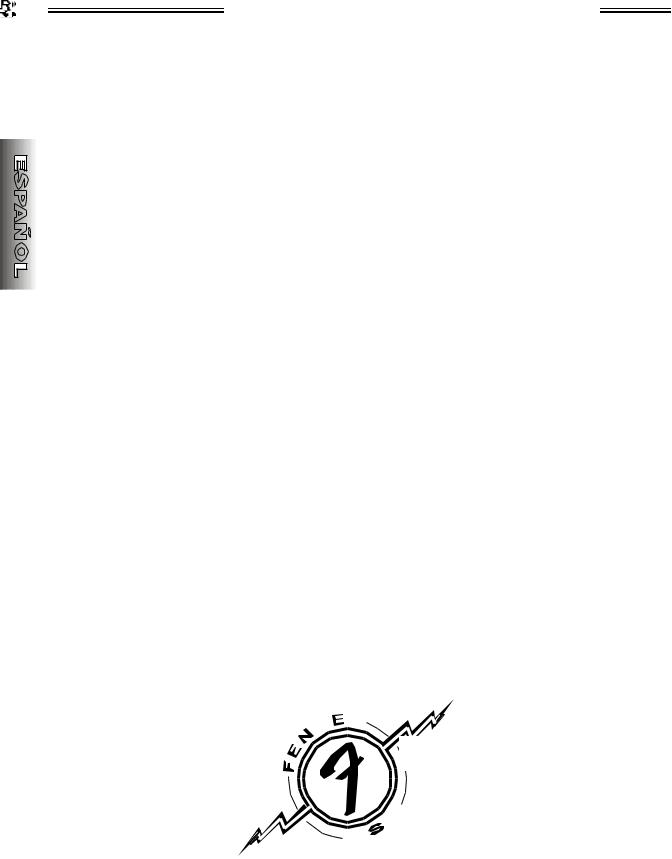
PRINCETON CHORUS DSP - FUNCIONES
Basado en el diseño clásico del amplificador [Fender Princeton Stereo Chorus TM] original, [Princeton Chorus DSP] se ha actualizado con [Digital Signal Processing] procesamiento de señal digital. Desarrollado en el propio laboratorio digital de [Fender], [Princeton Chorus DSP] dispone de 32 efectos estéreo con calidad de estudio que utilizan amplificadores de alimentación doble que permiten conservar una total separación estéreo. La posibilidad de seleccionar el modo Overdrive lo convierte prácticamente en un amplificador de dos canales. El modo Overdrive dispone de un sistema de circuitos de distorsión de preacentuación y desacentuación exclusivo de Fender que genera marcados altos suaves y gran fuerza como si se tratase de un amplificador distorsionado de tubo apilado.
El conmutador [MID BOOST] AUMENTAR MEDIOS proporciona otra voz de preacentuación mientras que el control [PRESENCE] PRESENCIA aporta una variación continua del contenido de alta frecuencia de la voz de desacentuación. El sistema de circuitos de ecualización a tres bandas establecido después de la distorsión, permite modificar posteriormente el sonido global del amplificador. Existe un único control
[LIMITER] LIMITADOR que se activa con la distorsión e impone a ésta límites exactos sin perder el apoyo que suele ofrecer una configuración [GAIN] GANANCIA alta. Se puede lograr un efecto dinámico si [LIMITER] LIMITADOR y [GAIN] GANANCIA tienen un valor alto; cuanto más fuerte se toque la guitarra con la púa, más limpia sonará la nota. El contenido armónico también aumentará a medida que las notas se mantengan.
El [FOOTSWITCH] CONMUTADOR DE PEDAL de 3 botones que se incluye permite activar o desactivar de forma remota el modo Overdrive y los efectos estéreo [DSP]. Multiplexado mediante un cordón de 1/4 de pulgada, el [FOOTSWITCH] CONMUTADOR DE PEDAL se puede conectar fácilmente a paneles de pedal remotos.
La versatilidad de [Princeton Chorus DSP] se puede expandir en gran medida mediante [EFFECTS LOOPS] BUCLES DE EFECTOS mono con balance y estéreo real que permiten la conexión con gran variedad de equipos, entre los que se incluyen los mezcladores para reforzar el sonido y grabación, los amplificadores secundarios y los dispositivos de efectos.
10

EFECTOS ESTÉREO DIGITALES - CONTROLES
•[REVERB/DELAY] (FIGURA A): Seleccione entre 5 [TYPES] TIPOS de efectos con la rueda [TYPE] TIPO:
[DELAY/REVERB]: mezcla de delay y reverb
[DELAY]: efecto delay digital de varias repeticiones
[ROOM]: simulación de la acústica de una habitación de
dimensiones medias
[HALL]: simulación de la acústica de una sala de gran tamaño
[PLATE]: simulación del efecto reverb que se utiliza en los estudio
de grabación
Dentro de cada [TYPE] TIPO es posible seleccionar entre un rango de
PORCENTAJES DE [REVERB/DELAY] predefinidos (numerados en
conjuntos, FIGURA A. Estos PORCENTAJES predefinidos serán mayores si se avanza en el sentido de las agujas del reloj dentro de dicho [TYPE] TIPO (dirección de las flechas, FIGURA A). Por ejemplo, los valores predefinidos con el número “1” en la FIGURA A, tendrán los POR-
CENTAJES DE [REVERB/DELAY] más pequeños.
FIGURA A
•[CHORUS/MODULATION] CHORUS/MODULACIÓN(FIGURA B): Seleccione entre 3 [TYPES] TIPOS de efectos con la rueda [TYPE] TIPO:
[CHORUS] 1: coro moderno y suntuoso
[CHORUS 2]: reproducción del efecto en el amplificador original [Princeton Stereo Chorus] [FLANGE]: efecto de delay corto mejorado
Dentro de cada [TYPE] TIPO es posible seleccionar entre un rango de PROFUNDIDADES de barrido [CHORUS/MODULATION] CHORUS/ MODULACIÓN predefinidas (numeradas en conjuntos, FIGURA B). Estas PROFUNDIDADES de barrido predefinidas aumentan si se avanza en el sentido de las agujas del reloj dentro de dicho [TYPE] TIPO (dirección de las flechas, FIGURA B). Por ejemplo, los valores predefinidos con el número “1” en la FIGURA B, tendrán las PROFUNDIDADES de barrido [CHORUS/MODULATION] CHORUS/MODULACIÓN más superficiales.
• [CHORUS/MODULATION] CHORUS/MODULATION (FIGURA C): Ajuste la [RATE] VELOCIDAD de barrido con la rueda [RATE] VELOCIDAD. Las [RATES] VELOCIDADES de barrido aumentan en el sentido de las agujas de reloj (dirección de la flecha en la FIGURA C). Por ejemplo, la [RATE] VELOCIDAD con el número “1” en la FIGURA C es la [RATE] VELOCIDAD de barrido más lenta.
FIGURA B |
FIGURA C |
11
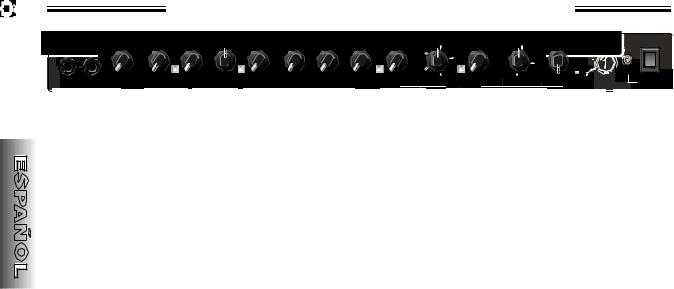
PRINCETON CHORUS DSP - PANEL FRONTAL
[A. INPUT 1] A. ENTRADA 1: conexión de enchufe de alta impedancia para guitarras u otros instrumentos.
[B. INPUT 2] B. ENTRADA 2: conexión de enchufe de baja impedancia para guitarras u otros instrumentos con preamplificadores activos.
NOTA: ambas entradas tienen una impedancia idéntica cuando se utilizan simultáneamente.
[C. VOLUME] C. VOLUMEN: ajusta el volumen global del amplificador cuando el modo Overdrive no está seleccionado ( [I. DRIVE SELECT] I. SELECCIÓN DE FUNCIONAMIENTO conmutador NO PULSADO).
NOTA: se debe seleccionar el modo Overdrive ( [I. DRIVE SELECT] I. SELECCIÓN DE FUNCIONAMIENTO conmutador PULSADO) para que funcionen los controles de [D. GAIN] D. GANANCIA a [J. VOLUME] J. VOLUMEN.
[D. GAIN] D. GANANCIA: ajusta la ganancia de preamplificador (distorsión). Se utiliza con [J. VOLUME] J. VOLUMEN para controlar el volumen global del amplificador.
[E. MID BOOST] E. AUMENTAR MEDIOS: activa un filtro de preacentuación especial que enfatiza las frecuencias medias cuando este conmutador está PULSADO.
[F. LIMITER] F. LIMITADOR: ajusta la compresión con una configuración de [D. GAIN] D. GANANCIA alta. La compresión se activa mediante distorsión en el preamplificador, por lo tanto no es tan perceptible con una configuración de [D. GAIN] D. GANANCIA baja.
[G. OVERDRIVE INDICATOR] G. INDICADOR DE OVERDRIVE: este LED se enciende cuando el amplificador se encuentra en el modo Overdrive.
[H. PRESENCE] H. PRESENCIA: ajusta la gama de frecuencias ultra altas que se produce después de la distorsión.
[I. DRIVE SELECT] I. SELECCIÓN DE FUNCIONAMIENTO: activa el modo Overdrive cuando este conmutador está PULSADO. NOTA: tanto [C. VOLUME] C. VOLUMEN como [FOOTSWITCH] CONMUTADOR DE PEDAL de selección de canal se desactivan cuando este conmutador está PULSADO.
[J. VOLUME] J. VOLUMEN: ajusta el volumen después de la distorsión. Se utiliza con [D. GAIN] D. GANANCIA para controlar el volumen global del amplificador.
[K. TREBLE] K. AGUDOS: ajusta la gama de frecuencias altas.
[L. MID] L. MEDIOS: ajusta la gama de frecuencias medias.
[M. BASS] M. GRAVES: ajusta la gama de frecuencias bajas.
[N. DEFEAT] N. ANULAR: silencia los efectos [DSP] del tipo [REVERB/DELAY] cuando este conmutador está PULSADO. Para activar la conmutación remota desde el [FOOTSWITCH] CONMUTADOR DE PEDAL, dicho conmutador no puede estar PULSADO.
[O. LEVEL] O. NIVEL: ajusta la cantidad de efectos [DSP] del tipo [REVERB/DELAY] que se van a mezclar con la señal en seco original.
[P. TYPE] P. TIPO: este control selecciona uno de los dieciséis efectos [REVERB/DELAY DSP] distintos. El conmutador [N. DEFEAT] N. ANULAR NO debe estar PULSADO, el control [O. LEVEL] O. NIVEL debe estar por encima de “1” y [REVERB/DELAY] en el [FOOTSWITCH] CONMUTADOR DE PEDAL remoto (si se utiliza) debe estar activo para que se oiga este efecto [DSP]. NOTA: consulte “[DSP STEREO EFFECTS - CONTROLS] EFECTOS ESTÉREO DSP: CONTROLES”, en la página 11.
[Q. DEFEAT] Q. ANULAR: silencia los efectos [DSP] del tipo [CHORUS/MODULATION] CHORUS/MODULACIÓN cuando este conmutador está PULSADO. Para activar la conmutación remota desde el [FOOTSWITCH] CONMUTADOR DE PEDAL, dicho conmutador NO puede estar PULSADO.
[R. LEVEL] R. NIVEL: ajusta la cantidad de efectos [DSP] del tipo [CHORUS/MODULATION] CHORUS/MODULACIÓN que se van a mezclar con la señal en seco original.
[S. TYPE] S. TIPO: este control selecciona uno de los dieciséis efectos [CHORUS/MODULATION DSP] CHORUS/MODULACIÓN DSP distintos. El conmutador [Q. DEFEAT] Q. ANULAR NO puede estar PULSADO, el control [R. LEVEL] R. NIVEL debe estar por encimade “1” y [CHORUS/MODULATION] CHORUS/MODULACIÓN en el [FOOTSWITCH] CONMUTADOR DE PEDAL remoto (si se utiliza) debe estar activo para que se oiga este efecto [DSP]. NOTA: consulte “[DSP STEREO EFFECTS - CONTROLS] EFECTOS ESTÉREO DSP: CONTROLES”, en la página 11.
[T. RATE] T. VELOCIDAD: ajusta la velocidad de barrido de los efectos [DSP] del tipo [CHORUS/MODULATION] CHORUS/MODULACIÓN. A medida que disminuya el valor, menor será la velocidad de barrido.
[U. DSP PEAK] U. VALOR MÁXIMO DSP: si este LED parpadea indicala posibilidad de que se produzcan cortes (distorsión) en alguno de los circuitos de efectos [DSP]. Es normal que parpadee periódicamente. Si el LED permanece encendido y se oye una distorsión no deseada, intente reducir los controles [VOLUME] VOLUMEN del amplificador, [R. LEVEL] R. NIVEL o [O. LEVEL] O.NIVEL.
[V. POWER INDICATOR] V. INDICADOR DE CORRIENTE: este LED se enciende cuando el amplificador está ENCENDIDO.
[W. POWER SWITCH] W. CONMUTADOR DE CORRIENTE: PULSE la parte inferior de este conmutador para ENCENDER el amplificador. PULSE la parte superior de este conmutador para APAGAR el amplificador.
12
